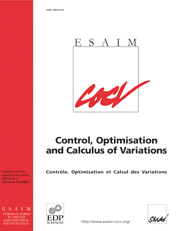Crossref Citations
This article has been cited by the following publications. This list is generated based on data provided by
Crossref.
Alessio, Francesca
and
Montecchiari, Piero
2007.
Brake orbits type solutions to some class of semilinear elliptic equations.
Calculus of Variations and Partial Differential Equations,
Vol. 30,
Issue. 1,
p.
51.
Ball, J. M.
and
Crooks, E. C. M.
2011.
Local minimizers and planar interfaces in a phase-transition model with interfacial energy.
Calculus of Variations and Partial Differential Equations,
Vol. 40,
Issue. 3-4,
p.
501.
Alessio, Francesca
and
Montecchiari, Piero
2013.
Layered solutions with multiple asymptotes for non autonomous Allen–Cahn equations in $${\mathbb {R}^{3}}$$.
Calculus of Variations and Partial Differential Equations,
Vol. 46,
Issue. 3-4,
p.
591.
Alessio, Francesca
and
Montecchiari, Piero
2014.
Multiplicity of layered solutions for Allen–Cahn systems with symmetric double well potential.
Journal of Differential Equations,
Vol. 257,
Issue. 12,
p.
4572.
Byeon, Jaeyoung
and
Rabinowitz, Paul H.
2014.
Solutions of higher topological type for an Allen–Cahn model equation.
Journal of Fixed Point Theory and Applications,
Vol. 15,
Issue. 2,
p.
379.
Rabinowitz, Paul H.
and
Montecchiari, Piero
2016.
On the existence of multi-transition solutions for a class of elliptic systems.
Annales de l'Institut Henri Poincaré C, Analyse non linéaire,
Vol. 33,
Issue. 1,
p.
199.
Byeon, Jaeyoung
Montecchiari, Piero
and
Rabinowitz, Paul H.
2016.
A double well potential system.
Analysis & PDE,
Vol. 9,
Issue. 7,
p.
1737.
Zuniga, Andres
and
Sternberg, Peter
2016.
On the heteroclinic connection problem for multi-well gradient systems.
Journal of Differential Equations,
Vol. 261,
Issue. 7,
p.
3987.
Byeon, Jaeyoung
and
Rabinowitz, Paul H.
2016.
Unbounded solutions for a periodic phase transition model.
Journal of Differential Equations,
Vol. 260,
Issue. 2,
p.
1126.
Sourdis, Christos
2016.
The Heteroclinic Connection Problem for General Double-Well Potentials.
Mediterranean Journal of Mathematics,
Vol. 13,
Issue. 6,
p.
4693.
Alessio, Francesca
and
Montecchiari, Piero
2017.
Brake orbit solutions for semilinear elliptic systems with asymmetric double well potential.
Journal of Fixed Point Theory and Applications,
Vol. 19,
Issue. 1,
p.
691.
Fusco, Giorgio
2017.
Layered solutions to the vector Allen-Cahn equation in $\mathbb{R}^2$. Minimizers and heteroclinic connections.
Communications on Pure & Applied Analysis,
Vol. 16,
Issue. 5,
p.
1807.
Fusco, Giorgio
Gronchi, Giovanni F.
and
Novaga, Matteo
2018.
On the existence of heteroclinic connections.
São Paulo Journal of Mathematical Sciences,
Vol. 12,
Issue. 1,
p.
68.
Sourdis, Christos
2019.
Energy minimality property of the connecting solution of the Painlevé phase transition model.
Applied Mathematics Letters,
Vol. 98,
Issue. ,
p.
381.
Smyrnelis, Panayotis
2021.
Vortex-filament solutions in the Ginzburg-Landau-Painlevé theory of phase transition.
Journal de Mathématiques Pures et Appliquées,
Vol. 156,
Issue. ,
p.
328.
Smyrnelis, Panayotis
2021.
Double layered solutions to the extended Fisher–Kolmogorov P.D.E..
Nonlinear Differential Equations and Applications NoDEA,
Vol. 28,
Issue. 5,
Fusco, Giorgio
2022.
On the structure of minimizers of the Allen-Cahn energy for $$Z_N$$ symmetric nonnegative potentials with $$N+1$$ zeros.
Calculus of Variations and Partial Differential Equations,
Vol. 61,
Issue. 6,
Oliver-Bonafoux, Ramon
2022.
Non-minimizing connecting orbits for multi-well systems.
Calculus of Variations and Partial Differential Equations,
Vol. 61,
Issue. 2,
Jendrej, Jacek
and
Smyrnelis, Panayotis
2022.
Nondegeneracy of heteroclinic orbits for a class of potentials on the plane.
Applied Mathematics Letters,
Vol. 124,
Issue. ,
p.
107681.
Smyrnelis, Panayotis
2024.
Modern Problems in PDEs and Applications.
Vol. 4,
Issue. ,
p.
119.
 to
$\xR$
to
$\xR$ , which vanishes exactly at two points a and b. Let
S1(a, b) be the set of functions of a real variable which tend
to a at -∞
and to b at +∞ and whose one dimensional energy
$$
E_1(v)=\int_\xR\bigl[W(v)+\lvert v'\rvert^2/2\bigr]\,\xdif x
$$
, which vanishes exactly at two points a and b. Let
S1(a, b) be the set of functions of a real variable which tend
to a at -∞
and to b at +∞ and whose one dimensional energy
$$
E_1(v)=\int_\xR\bigl[W(v)+\lvert v'\rvert^2/2\bigr]\,\xdif x
$$ is finite.
Assume that there exist two isolated minimizers z+ and z-
of the energy E1
over S1(a, b). Under a mild coercivity condition on the
potential W and a generic spectral condition on the linearization
of the
one-dimensional Euler–Lagrange operator at z+ and z-, it is
possible to prove that there exists a function u
from $\xR^2$
is finite.
Assume that there exist two isolated minimizers z+ and z-
of the energy E1
over S1(a, b). Under a mild coercivity condition on the
potential W and a generic spectral condition on the linearization
of the
one-dimensional Euler–Lagrange operator at z+ and z-, it is
possible to prove that there exists a function u
from $\xR^2$ to itself which satisfies the equation
$$
-\Delta u + \xDif W(u)^\mathsf{T}=0,
$$
to itself which satisfies the equation
$$
-\Delta u + \xDif W(u)^\mathsf{T}=0,
$$ and the boundary conditions
$$
\lim_{x_2\to +\infty} u(x_1,x_2)=z_+(x_1-m_+),\phantom{\mathbf{a}}
\lim_{x_2\to
-\infty} u(x_1,x_2)=z_-(x_1-m_-),
\lim_{x_1\to -\infty}u(x_1,x_2)=\mathbf{a},\phantom{z_+(x_1-m_+)}
\lim_{x_1\to+\infty}u(x_1,x_2)=\mathbf{b}.
$$
and the boundary conditions
$$
\lim_{x_2\to +\infty} u(x_1,x_2)=z_+(x_1-m_+),\phantom{\mathbf{a}}
\lim_{x_2\to
-\infty} u(x_1,x_2)=z_-(x_1-m_-),
\lim_{x_1\to -\infty}u(x_1,x_2)=\mathbf{a},\phantom{z_+(x_1-m_+)}
\lim_{x_1\to+\infty}u(x_1,x_2)=\mathbf{b}.
$$ The above convergences are exponentially fast; the numbers m+
and m- are unknowns of the problem.
The above convergences are exponentially fast; the numbers m+
and m- are unknowns of the problem.


